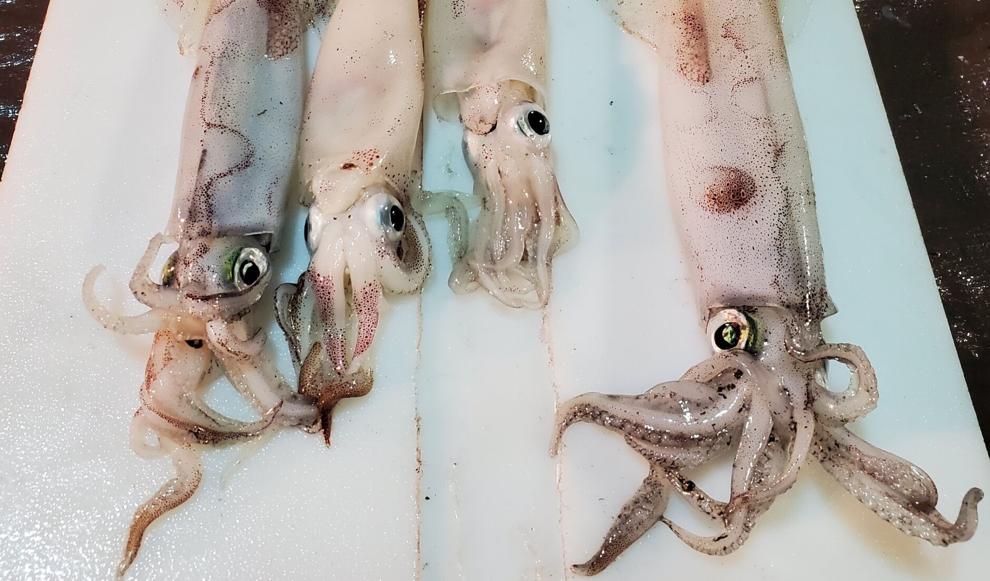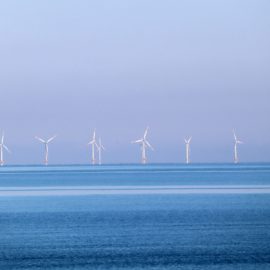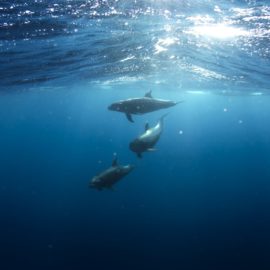
Will the wind turbans hurt fishing? The Block Island piece one said it does not, in fact it improved it. Here they say it will or is that just fear of the unknown? Nets may have trouble as they are dragged through the waters.
Robert Ballinger watches every inch of a long green net as it unfurls from a spool on the back of this boat, the Lena Pearl, one of dozens of fishing vessels packed into a tiny harbor in America’s smallest state. He’s concentrating, looking for any tears or debris that might cause trouble next time he’s trawling off the coasts of Rhode Island and Massachusetts. He’d prefer to focus on small problems like these and ignore the big one on his mind: the growing array of wind turbines sprouting along the coast. He wouldn’t have much issue with them, he said, if they didn’t happen to work best in the same deep, wind-swept waters where he finds his most lucrative catch. “Where they want to put those turbines is right where all these are during the summer,” he said, grabbing a squid from the deck and giving its slimy, silvery body a frustrated squeeze. “And the amount they want to put in — it’s mind-boggling. It will change the entire squid season.”
nola.com
I will be the shrimp business that would suffer if there is a problem.
Squid is to Rhode Island what lobster is to Maine and shrimp is to Louisiana. More than 22 million pounds are landed each year, making it by far Rhode Island’s biggest fishery, and almost all of it comes through the harbor at Point Judith. Ballinger fishes a variety of species — whiting, fluke, butterfish — but he makes half his money catching squid between July and October. The country’s first offshore wind project, the Block Island Wind Farm, was built about 14 miles south of here in 2016. A much larger one, known as Vineyard Wind, is set to begin construction about 40 miles to the east, near Martha’s Vineyard. By the end of the decade, some 2,000 turbines could be clustered along the coast from Massachusetts to North Carolina, according to the Biden administration, which is expediting wind farm permitting to reach its goal of generating 30,000 megawatts from offshore wind by 2030. Where offshore wind advocates see one of the best options for curbing climate change, fishers see a maze of obstacles that will make their jobs tougher and more dangerous. “Wind farms are getting a tremendous political push, whereas the people who fish are being crushed,” said Greg Matarones, president of the Rhode Island Lobstermen’s Association.

PHOTO FROM COMMERCIAL FISHERIES RESEARCH FOUNDATION
With the interest now on the Gulf, a closer look is being done here.
Now, offshore wind developers are starting to turn their attention to the Gulf of Mexico, where the offshore oil and gas industry has cultivated a ready and willing workforce and easily adaptable ports and other infrastructure. But the Gulf is also the source of 70% of the country’s shrimp. Of the more than 200 million pounds of shrimp netted in the Gulf each year, much of it was caught in the waters off the Louisiana and Texas coasts. These prime fishing waters happen to overlap with the areas of the Gulf that have the greatest potential for wind energy development. So the conflicts in the East may soon be headed south, said Acy Cooper, a Venice shrimper and president of the Louisiana Shrimp Association. “We have the same concerns as the guys up there on the East Coast,” he said. “We know the (wind farms) are coming, but we don’t know where and how much ground is going to be taken from us.” Ballinger has a warning for Gulf fishers: “They better hope the wind farm companies screw this up so bad here that they don’t ever come down to the Gulf.”
There are uncertainties of anything underwater. There will be transmission lines to get the energy to the customers. The construction will be underwater before the turbines can be attached. All of these, and more, concern the fishing industry.
With just five turbines, the Block Island Wind Farm is tiny compared with the projects in the construction pipeline. It was installed relatively close to shore and on the kind of rocky sea bottom trawlers avoid. But there’ve been plenty of problems with the transmission line that carries electricity from the turbines to the mainland. Despite promises it would be buried, large sections sit exposed on the seafloor. Orsted, the Danish energy company that owns the farm, has placed blocks and mats on the exposed sections, but these protections pose snag hazards for drag netters in what Ballinger said was a “sweet spot” for squid. “I’ve wrecked two nets on it, and various other guys have wrecked nets on it,” he said. Near Ballinger’s boat, squid fisher Sam Tucker and his three-person crew were offloading a ripped net. It likely wasn’t damaged by the cable because he and other fishers now avoid it. Fixing the net will cost Tucker four fishing days and $10,000. “The net looks rugged, but it’s fragile and temperamental,” Tucker said. “It’s like an underwater kite.”
Spacing the turbines is also a problem as the nets are wide.
Ever try flying a kite in a forest? That’s what it will be like to fish among the 62 turbines Vineyard Wind initially plans to build across 65,000 acres of prime squid fishing grounds, Tucker said. Slaloming through the turbines is a dangerous prospect, even if they’re installed a mile apart. Throw in the 79 additional turbines planned for phase two, as well as the development of neighboring wind energy lease areas that cover five times as much ocean, and it could spell the end of the fishery, Tucker said. Lobster fishers might be hit even harder. Turbines act as artificial reefs, sometimes fostering a profusion of mussels and other creatures. That can be a good thing, but not for lobsters. Reefs tend to increase the concentrations of black sea bass, a voracious eater that’s spreading north into the waters off New England as ocean temperatures rise. “The sea bass love to eat baby lobsters,” said Matarones, of the Lobstermen’s Association. “They’re like vacuum cleaners. When they find a spot, they go at it till there’s nothing left.” Lobster fishers already say they’re being boxed in by a host of new federal fishing restrictions aimed at saving the critically endangered North Atlantic right whale. Numbering fewer than 400, the whales are vulnerable to entanglement in fishing gear, particularly the buoy lines of lobster traps. Closing off large areas of whale habitat while allowing a proliferation of wind turbines leaves little room for fishers.
Talk to us. Understand our problems. Work with us to we get a Win-Win situation.
“Wind farms are a good idea, but they can’t displace the people making a livelihood out here,” Tucker said. “There’s a better way.” For Tucker, the better way would be for wind energy developers to work closely with fishers and take their concerns seriously. Vineyard Wind wouldn’t comment for this story, but the trade group American Clean Power defended the company’s efforts to “coexist with the commercial fishing industry,” including modifying turbine layouts, hiring fisheries liaisons and fishers to staff survey vessels, and funding cooperative research with fisheries groups. It’s true wind energy companies have held several meetings and gathered a lot of input, but it amounted to little for fishers, said Annie Hawkins, executive director of the Responsible Offshore Development Alliance, a group that advocates for the fishing industry. “We put in hundreds and hundreds of hours of work with (wind farm developers), and then it’s totally dismissed,” she said. The process seemed merely for show. “It’s to check a box and move on,” Hawkins said.
Once again to the courts. Each side is right, just ask them.
Last month, the group filed notice of intent to sue the federal government over its approval of the Vineyard Wind project. The group argues that the Vineyard Wind development will impede safe navigation for fishing boats and establishes a template for other projects that will also harm the fishing industry. The U.S. Bureau of Ocean Energy Management, which oversees offshore energy leases, had considered the advocacy group’s request for 4-mile-wide transit lanes through the wind farm but recently abandoned the requirement. The approved 1-mile gaps between turbines is too narrow for fishing and search-and-rescue operations, the advocacy group said in its notice. It also alleges the Vineyard Wind project violates federal law that requires a “fair return” for leases in federal waters.
Transit lanes are needed but if 1 mile is too small maybe 4 is more than needed. Communication is needed.
The federal government is charging Vineyard Wind $3 per acre and no royalties from energy production. That’s in sharp contrast to the starting bid of $25 per acre and production royalties required from oil and gas leases. Still, the struggles on the East Coast might not carry over to the Gulf, said Mike Celata, the Gulf region director for the federal agency. By the time leasing happens in the Gulf, the process will be improved and refined, he said. Celata pledged to begin discussions with Gulf shrimpers and other commercial fishing groups well before the lease sale process begins in 2025. “A lesson we’ve learned is we want to meet early and often,” he said. “We’ve committed to that.” Cooper, of the Louisiana Shrimp Association, commended the agency for already starting to make the rounds at Gulf fishing industry meetings. “They’re trying to win us over,” he said.
Things won’t get worse. That is a promise. Already the fishers are combating the pipes all around the floor of the Gulf.
The agency has promoted the idea that wind farms won’t be any worse for fishing than the 3,500 offshore oil and gas structures already in the Gulf, not to mention 27,000 miles of underwater pipelines, most of which are inactive or abandoned. Cooper agrees shrimpers are accustomed to the Gulf’s industrial obstacle courses, but it doesn’t mean they like it. The introduction of offshore wind infrastructure increases navigational challenges. “There are a lot of platforms and all that, and we’ve been dealing with them a long time,” he said. “But wind farms are a whole new ballgame.” The Southern Shrimp Alliance has taken the bold step of asking the agency to ban wind energy leases in almost all areas where shrimping activity occurs. Its proposed restricted area, laid out in an 11-page letter to the agency, stretches between Port Isabel, Texas, to Gulf Shores, Alabama — including the entire Louisiana coast — and, in some areas, extends well beyond 100 miles from the coast. If wind leasing is permitted in this area, the alliance urged the agency to pay special attention to how transmission lines can affect shrimpers, particularly the ones who fish close to shore. About 87% of the Gulf’s more than 11,000 shrimp vessels are small, shallow-water boats that ply state-managed waters. Although the gusts in these areas aren’t strong enough to attract big wind farms, shrimpers will still have to worry about snagging their nets on transmission lines running between deep-water turbines and mainland substations.
Other problems are noted, but we do hear this from industry when a new requirement is added, and they always seem to cope.
The alliance asked that the agency establish programs to compensate shrimpers for “the inevitable loss or damages” to nets and other gear. Taking a lesson from all the old oil and gas infrastructure that’s been allowed to rust in the Gulf, the alliance also urged the agency to require wind developers to put aside money for removing turbines and transmission lines once they’re shut down or knocked out of commission by storms. Gulf shrimpers say much is at stake beyond their livelihoods. The fishery is an economic engine for the region, generating almost $800 million per year for hundreds of shrimp dealers and processors, as well as grocers and restaurants that rely on the potent marketability of wild-caught shrimp. East Coast fishers say they tried the same tactic but quickly learned their talk of millions of dollars goes unheard when the energy industry speaks of the billions to be made with offshore wind. “Why won’t they negotiate with fishermen?” said Tucker, the Rhode Island squid fisher. “Because people are making a killing off turbines. They don’t have to worry about us.”
This ends the 5 part series and what it shows is that first of all the turbines are coming. The Gulf can learn from what has gone before. The industry will have to change but it has before. THat may be what helps us as we are transitioning from oil rigs to wind turbines and so there will be similarities. We have two competing goods – fish and renewable energy. We need both. Then need to talk and work together.



